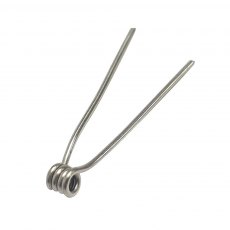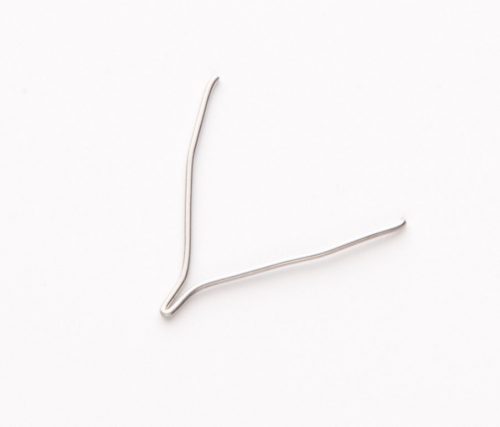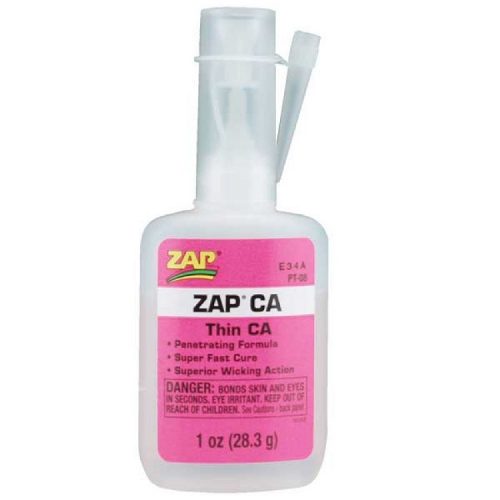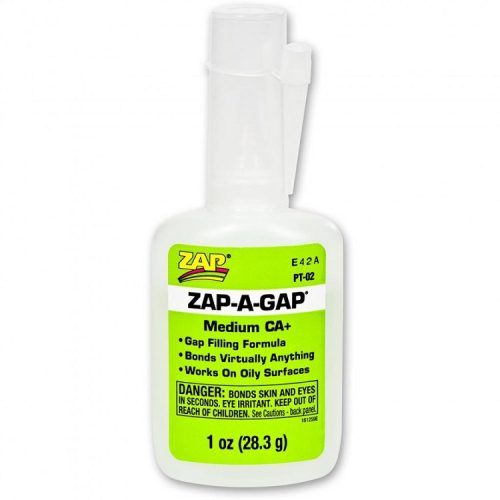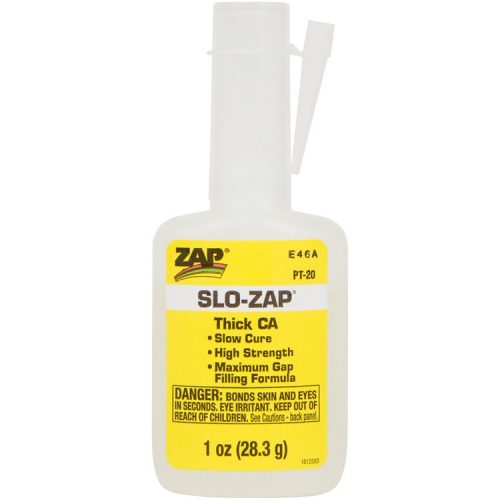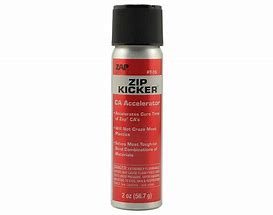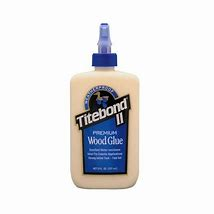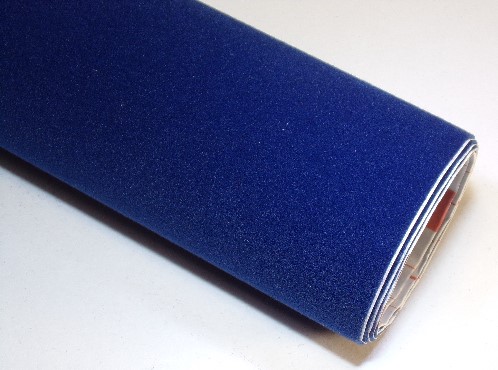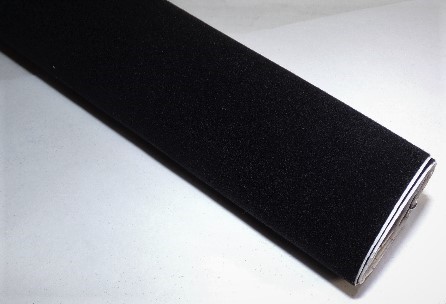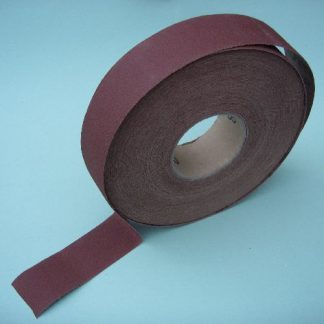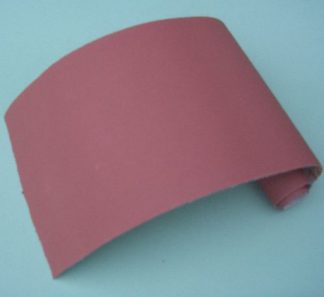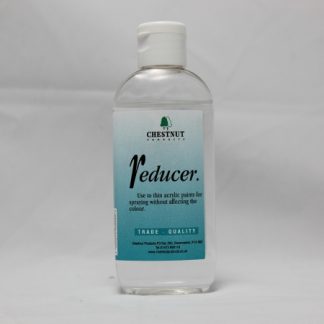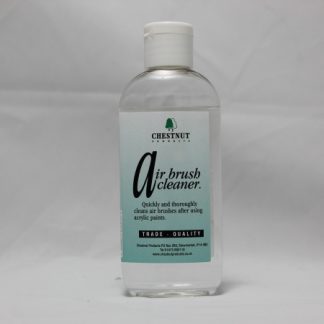- Fine control of heat and precise handling of the burning head, variable heat, up to 1100º C.
- The pen (for handpiece) has a cool running and lightweight handle which remains comfortable even after many hours of use.
- Writes quickly and as fluently as a fountain pen.
- Cost effective replacement points.
- The ability to shape your own points from specialist wire with the supplied fine wire, perfect for fine detailed burning. Thicker wire is available, ideal for enhancing bird or stick carving.
-
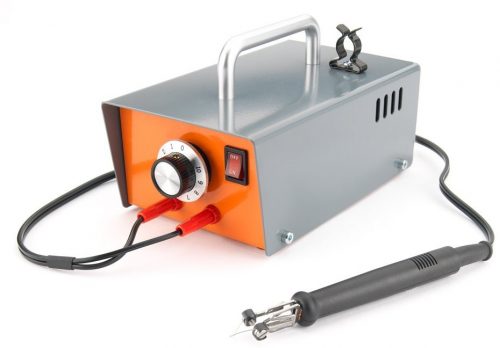
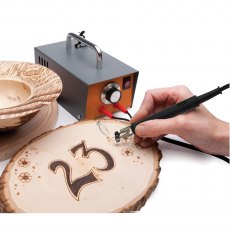 Features:
Features: -
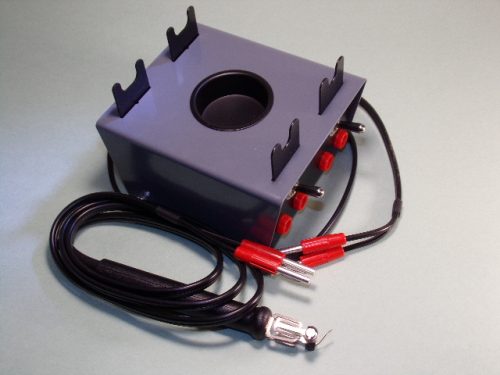
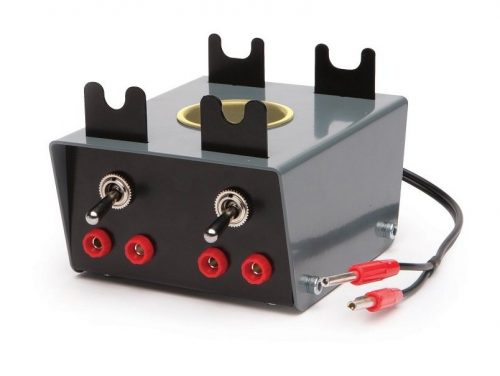
- Designed for use with the Peter Child Pyrography machine: two pen flexibility at the flick of a switch.
-
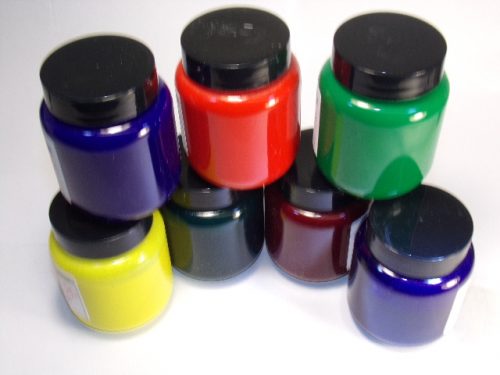 Llewellyn Ryland Polyester Pigment are coloured liquid/paste mediums based on pigments dispersed within a solvent-free reactive unsaturated polyester resin. They are available in a wide range of colours varying in strength and consistency depending upon the particular colouring application. They have been developed to blend easily into resin systems. The range of colours is based upon pigments carefully selected for colour fastness, opacity, heat stability and having minimum effect upon the curing characteristics of the final system. The resin used with the Polyester Colour Paste is a specially developed solvent-free reactive polyester resin which chemically cross links with the moulding resin so that the colour is "locked in" once the system has cured. They can be used to colour most polyester resin based systems used within the composites or related industry. These Polyester Colour Pastes have excellent stability.
Llewellyn Ryland Polyester Pigment are coloured liquid/paste mediums based on pigments dispersed within a solvent-free reactive unsaturated polyester resin. They are available in a wide range of colours varying in strength and consistency depending upon the particular colouring application. They have been developed to blend easily into resin systems. The range of colours is based upon pigments carefully selected for colour fastness, opacity, heat stability and having minimum effect upon the curing characteristics of the final system. The resin used with the Polyester Colour Paste is a specially developed solvent-free reactive polyester resin which chemically cross links with the moulding resin so that the colour is "locked in" once the system has cured. They can be used to colour most polyester resin based systems used within the composites or related industry. These Polyester Colour Pastes have excellent stability. -
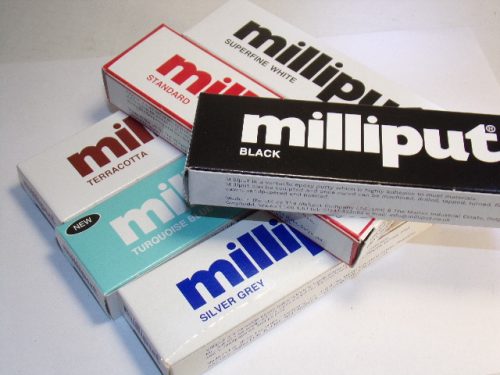 Milliput Epoxy Putty, the two sticks have a long shelf life but once mixed the resultant putty is at first soft and highly adhesive and then gradually hardens. Speed of hardening is dependant on temperature and at normal temperatures (20-25ºC) Milliput becomes rock hard in three to four hours. By the application of heat the setting time can be reduced to a few minutes. After setting hard Milliput continues to cure and is fully cured after an elapse of time equal to the setting time at the same temperature. Once fully cured Milliput can be machined, drilled, tapped, turned, filed, sawn, sandpapered and painted. Milliput can be sandpapered and painted immediately it has set. (it is advisable to wear eye protection during this process). Milliput is an excellent adhesive and will bond any of the following to itself or to any of the others - wood, brick, cement, metals, concrete, plastics, glass etc, but note that Milliput is not intended as a thin layer adhesive and should not be used where a paste, mucilage or thin glue is indicated. Milliput will set under water and is heat resistant up to 130°C. Shelf Life: Recommended that Milliput is stored in cool, dry conditions. Please reseal bags after use. Stored correctly this product should remain workable for about 2 years. Available in six colours: Standard (Yellow/Grey), Terracotta, Silver Grey, Black, Superfine White and Turquoise Blue.
Milliput Epoxy Putty, the two sticks have a long shelf life but once mixed the resultant putty is at first soft and highly adhesive and then gradually hardens. Speed of hardening is dependant on temperature and at normal temperatures (20-25ºC) Milliput becomes rock hard in three to four hours. By the application of heat the setting time can be reduced to a few minutes. After setting hard Milliput continues to cure and is fully cured after an elapse of time equal to the setting time at the same temperature. Once fully cured Milliput can be machined, drilled, tapped, turned, filed, sawn, sandpapered and painted. Milliput can be sandpapered and painted immediately it has set. (it is advisable to wear eye protection during this process). Milliput is an excellent adhesive and will bond any of the following to itself or to any of the others - wood, brick, cement, metals, concrete, plastics, glass etc, but note that Milliput is not intended as a thin layer adhesive and should not be used where a paste, mucilage or thin glue is indicated. Milliput will set under water and is heat resistant up to 130°C. Shelf Life: Recommended that Milliput is stored in cool, dry conditions. Please reseal bags after use. Stored correctly this product should remain workable for about 2 years. Available in six colours: Standard (Yellow/Grey), Terracotta, Silver Grey, Black, Superfine White and Turquoise Blue. -
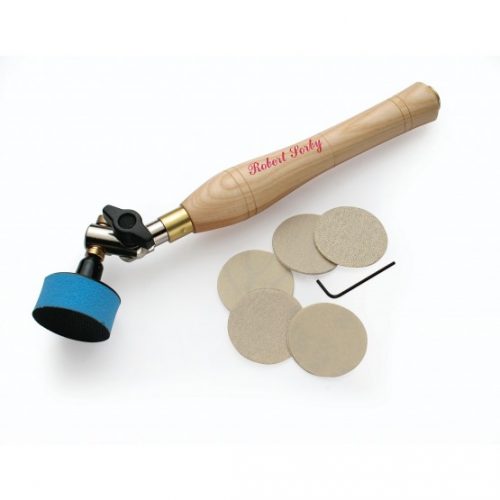 The Sandmaster is an essential part of every turner's tool kit. It comes with 5 different grits of abrasive to take even the roughest projects to a glass-like finish every time. It avoids an uneven finish often associated with hand sanding and there is no danger of catching hands on the revolving project. There is little or no surface damage/head build-up, as there is with power sanding and there is no cable to trip over. Head articulates to access even the most difficult areas. Sponge head is ideal for working in tight spaces. Sandmaster creates a fraction of the dust generated by power sanding. It can be adapted to take a polishing mop.
The Sandmaster is an essential part of every turner's tool kit. It comes with 5 different grits of abrasive to take even the roughest projects to a glass-like finish every time. It avoids an uneven finish often associated with hand sanding and there is no danger of catching hands on the revolving project. There is little or no surface damage/head build-up, as there is with power sanding and there is no cable to trip over. Head articulates to access even the most difficult areas. Sponge head is ideal for working in tight spaces. Sandmaster creates a fraction of the dust generated by power sanding. It can be adapted to take a polishing mop. -
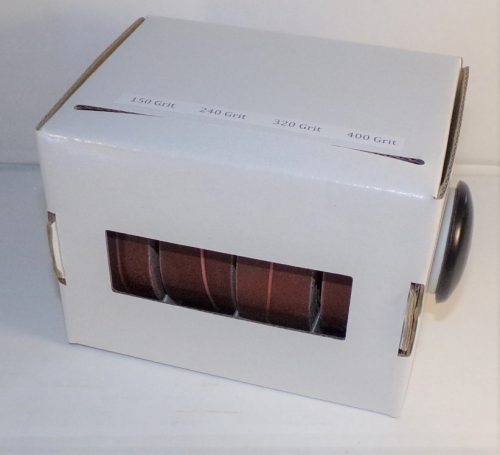 1" x 20' abrasive in a convenient dispenser. Perfect for spindle, pen, or any turning where small strips are needed. This convenient dispenser is loaded with four or 1" x 20' rolls of cloth backed aluminum oxide abrasive. Each dispenser pack contains one roll of 150, 240, 320 & 400 grit abrasive. Just pull out and tear off the length of abrasive strip you need.
1" x 20' abrasive in a convenient dispenser. Perfect for spindle, pen, or any turning where small strips are needed. This convenient dispenser is loaded with four or 1" x 20' rolls of cloth backed aluminum oxide abrasive. Each dispenser pack contains one roll of 150, 240, 320 & 400 grit abrasive. Just pull out and tear off the length of abrasive strip you need. -
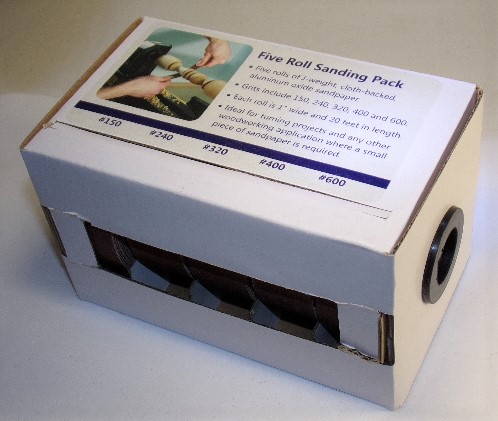 1" x 20' abrasive in a convenient dispenser. Perfect for spindle, pen, or any turning where small strips are needed. This convenient dispenser is loaded with five 1" x 20' rolls of cloth backed aluminum oxide abrasive. Each dispenser pack contains one roll of 150, 240, 320, 400 & 600 grit abrasive. Just pull out and tear off the length of abrasive strip you need.
1" x 20' abrasive in a convenient dispenser. Perfect for spindle, pen, or any turning where small strips are needed. This convenient dispenser is loaded with five 1" x 20' rolls of cloth backed aluminum oxide abrasive. Each dispenser pack contains one roll of 150, 240, 320, 400 & 600 grit abrasive. Just pull out and tear off the length of abrasive strip you need. -
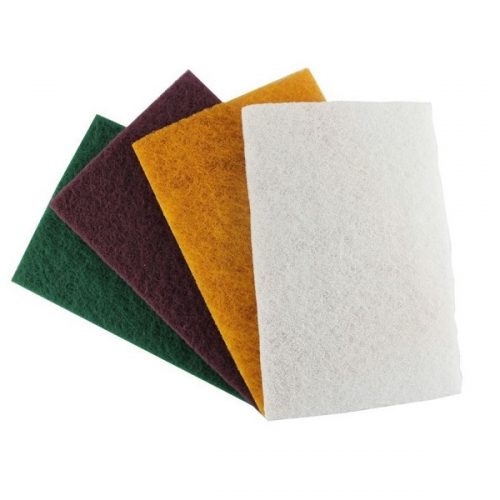 Fine finishing starts with good preparation! Use these mildly abrasive pads after sanding for that final smoothing process to give a near-perfect surface prior to applying any finish. Very long lasting, these pads are also very flexible and do not crumble, thus avoiding any fear of contamination of your work. Exercise care when using these pads with the lathe revolving.
Fine finishing starts with good preparation! Use these mildly abrasive pads after sanding for that final smoothing process to give a near-perfect surface prior to applying any finish. Very long lasting, these pads are also very flexible and do not crumble, thus avoiding any fear of contamination of your work. Exercise care when using these pads with the lathe revolving. -
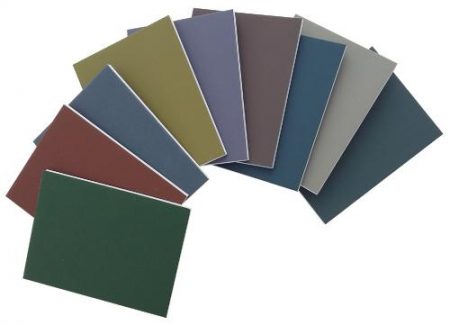 Designed specifically with pen turners in mind. This finishing kit consists of nine different, colour coded, foam backed sanding pads measuring 10cm (4") x 8.5cm (3.1/4"). Includes the following grit sizes: 1500 - Rust 1800 - Green 2400 - Black 3200 - Tan 3600 - Wine/Brown 4000 - Teal 6000 - Purple 8000 - Royal Blue 12000 - Grey Suitable for wood and acrylic blanks .
Designed specifically with pen turners in mind. This finishing kit consists of nine different, colour coded, foam backed sanding pads measuring 10cm (4") x 8.5cm (3.1/4"). Includes the following grit sizes: 1500 - Rust 1800 - Green 2400 - Black 3200 - Tan 3600 - Wine/Brown 4000 - Teal 6000 - Purple 8000 - Royal Blue 12000 - Grey Suitable for wood and acrylic blanks . -

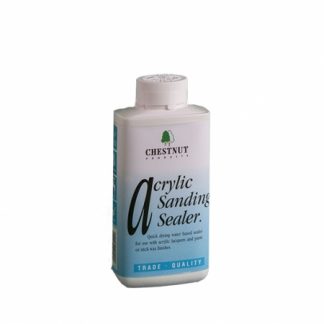
 This water based sanding sealer gets the job done without the smell associated with solvent based sealers and also with no flammability issues – ideal for asthma suffers and anyone with an aversion to solvent based finishes.
Applied by cloth, brush or spray (Chestnuts' foam brushes are especially good with this) the sealer dries in about 5 minutes and can be overcoated with most compatible finishes after about 20 minutes although two hours should be left if using Acrylic Lacquer.
Acrylic Sanding Sealer sands easily with a fine abrasive and is supplied ready for use.
This water based sanding sealer gets the job done without the smell associated with solvent based sealers and also with no flammability issues – ideal for asthma suffers and anyone with an aversion to solvent based finishes.
Applied by cloth, brush or spray (Chestnuts' foam brushes are especially good with this) the sealer dries in about 5 minutes and can be overcoated with most compatible finishes after about 20 minutes although two hours should be left if using Acrylic Lacquer.
Acrylic Sanding Sealer sands easily with a fine abrasive and is supplied ready for use.

-

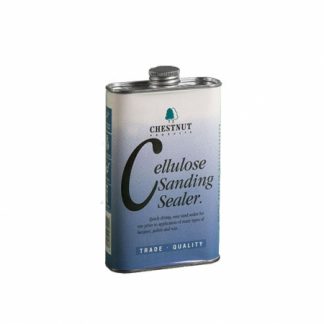
 Good finishing requires a good foundation, and Cellulose Sanding Sealer is probably the best way of providing one. Compatible with everything in the Chestnut Products range that benefits from the use of a sanding sealer (which is pretty much everything apart from oil finishes!) it is superbly universal.
The purpose of a sanding sealer is manifold.
Good finishing requires a good foundation, and Cellulose Sanding Sealer is probably the best way of providing one. Compatible with everything in the Chestnut Products range that benefits from the use of a sanding sealer (which is pretty much everything apart from oil finishes!) it is superbly universal.
The purpose of a sanding sealer is manifold.
- It seals the open pores of the timber prior to the application of the next coat, meaning that more of it stays on the surface and less of the finish is needed. Not only does this make it economical, when finishing the thinner the applied coat the less likely it is to get damaged, so a sanding sealer will help the top coats be more resilient.
- Sanding Sealers also bind the loose fibres of the timber together giving a more solid foundation for the next coat, which helps make sure the final finish is able to adhere properly and thus be more durable.
- They also include a sanding agent which acts as a lubricant to make the sanding process easier – the sanding agent also stands slightly proud of the surface of the sealer and it is this that is denibbed – the sealer itself should still be intact after sanding.

-

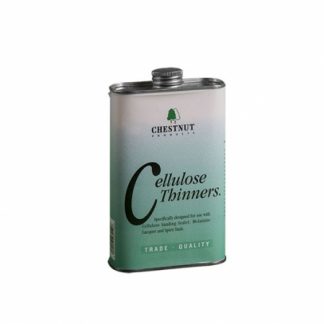 This pure cellulose solvent is a high quality dilutant for our cellulose based products, such as Cellulose Sanding Sealer and Melamine Lacquer. Thinning these products can help to make them easier to apply, especially over larger areas as it helps them flow out. Cellulose Thinners is also useful for cleaning any spills you may have in the workshop and is strong enough to help clean most things, taking care to ensure that it does not attack It can also be used to thin Spirit Stain to give a delicate wash effects, although spirit thinners is the better option for this.
This pure cellulose solvent is a high quality dilutant for our cellulose based products, such as Cellulose Sanding Sealer and Melamine Lacquer. Thinning these products can help to make them easier to apply, especially over larger areas as it helps them flow out. Cellulose Thinners is also useful for cleaning any spills you may have in the workshop and is strong enough to help clean most things, taking care to ensure that it does not attack It can also be used to thin Spirit Stain to give a delicate wash effects, although spirit thinners is the better option for this.
-

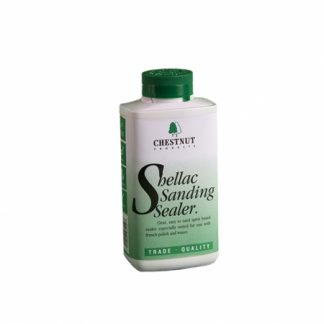
 Shellac Sanding Sealer is the traditional way of sealing timber prior to applying a polish or a wax.
Chestnuts version has a high percentage of real shellac which means it does the job extremely well, dissolved in an ethanol solution to make it easy to apply and quick drying.
Applied by cloth, brush or spray it dries in about 20 minutes, making it very popular for cabinet and architectural work as it is easy to keep a wet edge running. It is also popular with woodturners and highlights the natural grain of the timber extremely well.
Sand back lightly after application and apply Friction Polish, French Polish or any of Chestnuts waxes on top.
Conforms to EN71 Part 3 – suitable for toys and nursery furniture.
Shellac Sanding Sealer is the traditional way of sealing timber prior to applying a polish or a wax.
Chestnuts version has a high percentage of real shellac which means it does the job extremely well, dissolved in an ethanol solution to make it easy to apply and quick drying.
Applied by cloth, brush or spray it dries in about 20 minutes, making it very popular for cabinet and architectural work as it is easy to keep a wet edge running. It is also popular with woodturners and highlights the natural grain of the timber extremely well.
Sand back lightly after application and apply Friction Polish, French Polish or any of Chestnuts waxes on top.
Conforms to EN71 Part 3 – suitable for toys and nursery furniture.

-

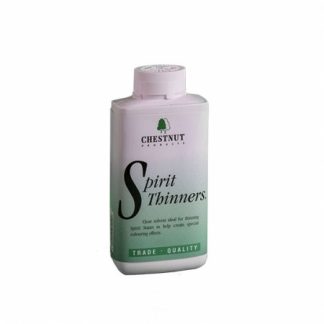 This clear, slower drying solvent is primarily for thinning our Spirit Stain to give delicate wash effects without affecting the colour (as methylated spirit would). It can also be used to dilute Friction Polish or French Polish if needed (usually only when the cap has been left off and the product has thickened up). It’s also suitable for use in making french polish if you want to dissolve shellac flakes in it.
This clear, slower drying solvent is primarily for thinning our Spirit Stain to give delicate wash effects without affecting the colour (as methylated spirit would). It can also be used to dilute Friction Polish or French Polish if needed (usually only when the cap has been left off and the product has thickened up). It’s also suitable for use in making french polish if you want to dissolve shellac flakes in it.
-

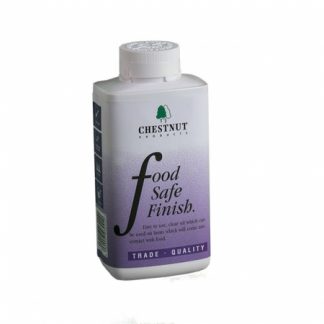 Food Safe Finish is a clear, food grade mineral oil. Chestnut use a thin grade of oil to allow it to soak into bare timber which then protects it against water splashes etc whilst not tainting or affecting the food in any way. It dries to a fairly matt finish; it is however ideal to use for wet sanding and when used with a very fine abrasive it can give an exceptionally smooth surface which has its own gentle glow. Apply with a clean cloth or brush direct onto bare wood, up to three coats are recommended. If the oil sits on the surface and won’t soak in it means the timber has absorbed as much as it can and no further coats are needed. Any surplus can be removed with a clean cloth if required. Depending on the way the item is used it might be necessary to top-up the finish, especially if it is washed regularly.
Food Safe Finish is a clear, food grade mineral oil. Chestnut use a thin grade of oil to allow it to soak into bare timber which then protects it against water splashes etc whilst not tainting or affecting the food in any way. It dries to a fairly matt finish; it is however ideal to use for wet sanding and when used with a very fine abrasive it can give an exceptionally smooth surface which has its own gentle glow. Apply with a clean cloth or brush direct onto bare wood, up to three coats are recommended. If the oil sits on the surface and won’t soak in it means the timber has absorbed as much as it can and no further coats are needed. Any surplus can be removed with a clean cloth if required. Depending on the way the item is used it might be necessary to top-up the finish, especially if it is washed regularly.
-

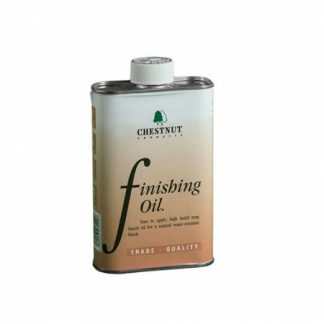
 Chestnut Finishing Oil is Chestnuts' version of Danish Oil* and uses Tung Oil as its base but with the addition of solvents and driers. This aids the drying of the product and speeds it up dramatically, so that it’s dry within eight hours. It has a pale amber colour and dries to a hard yet flexible film which is very hardwearing and water resistant.
For a high gloss finish apply several coats with a light rub down between coats; after 5 or 6 coats a good sheen should be visible.
Finishing Oil is normally applied by cloth but on larger areas a brush can be used very successfully.
Chestnut Finishing Oil is Chestnuts' version of Danish Oil* and uses Tung Oil as its base but with the addition of solvents and driers. This aids the drying of the product and speeds it up dramatically, so that it’s dry within eight hours. It has a pale amber colour and dries to a hard yet flexible film which is very hardwearing and water resistant.
For a high gloss finish apply several coats with a light rub down between coats; after 5 or 6 coats a good sheen should be visible.
Finishing Oil is normally applied by cloth but on larger areas a brush can be used very successfully.

-
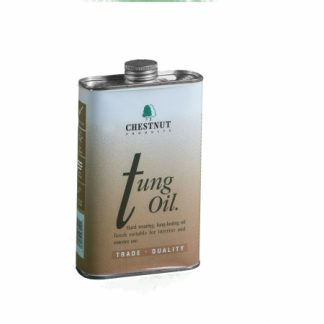 Tung Oil, or Chinese Wood Oil as it’s sometimes called, is a natural oil derived from the seed of the nut of the tung tree. The jury is out as to whether it can spark a nut allergy. Tung Oil air dries to form a tough, hard film that has a fairly strong amber tint. Because it doesn’t have any solvent or driers in it it can take a while to dry, and dependant on conditions this can be up to a week although 48 hours is more common. As with most finishes a thinner coat will dry quicker. Normally applied with a brush or cloth.
Tung Oil, or Chinese Wood Oil as it’s sometimes called, is a natural oil derived from the seed of the nut of the tung tree. The jury is out as to whether it can spark a nut allergy. Tung Oil air dries to form a tough, hard film that has a fairly strong amber tint. Because it doesn’t have any solvent or driers in it it can take a while to dry, and dependant on conditions this can be up to a week although 48 hours is more common. As with most finishes a thinner coat will dry quicker. Normally applied with a brush or cloth. -

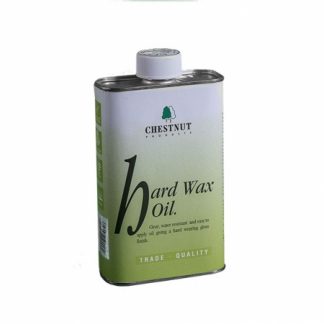
 If you’re looking for a clear finish that is tough, hardwearing and gives a satin lustre yet is still very easy to apply, even on larger areas, you’re in the right place.
Hard Wax Oil is a particular blend of tough oils combined with special waxes which dries to an exceptionally resilient finish. Ideal for anything that is going to be subjected to water splashes or a lot of handling this oil may not be indestructible but it will stand up to a lot of abuse.
It retains the ease of application typical of an oil and it stays wet long enough to get a smooth, even finish – even on large areas – but is touch dry and tack free in about 20 minutes, and better yet is ready for a second coat after about four hours (in normal conditions).
Hard Wax Oil will build to a bright gloss finish after 2-3 coats. Rub down lightly between coats with a fine abrasive. Once hard dry (allow at least 24 hours) it can be brought to an even brighter shine using either the buffing wheel system or burnishing cream.
For a not-quite-so-bright finish use a mild abrasive to reduce the gloss. For best results lubricate the abrasive with microcrystalline wax to retain the toughness of the oil.
If you’re looking for a clear finish that is tough, hardwearing and gives a satin lustre yet is still very easy to apply, even on larger areas, you’re in the right place.
Hard Wax Oil is a particular blend of tough oils combined with special waxes which dries to an exceptionally resilient finish. Ideal for anything that is going to be subjected to water splashes or a lot of handling this oil may not be indestructible but it will stand up to a lot of abuse.
It retains the ease of application typical of an oil and it stays wet long enough to get a smooth, even finish – even on large areas – but is touch dry and tack free in about 20 minutes, and better yet is ready for a second coat after about four hours (in normal conditions).
Hard Wax Oil will build to a bright gloss finish after 2-3 coats. Rub down lightly between coats with a fine abrasive. Once hard dry (allow at least 24 hours) it can be brought to an even brighter shine using either the buffing wheel system or burnishing cream.
For a not-quite-so-bright finish use a mild abrasive to reduce the gloss. For best results lubricate the abrasive with microcrystalline wax to retain the toughness of the oil.

-


 If you’re looking for a clear finish that is tough, hardwearing and gives a bright gloss yet is still very easy to apply, even on larger areas, you’re in the right place.
Hard Wax Oil is a particular blend of tough oils combined with special waxes which dries to an exceptionally resilient finish. Ideal for anything that is going to be subjected to water splashes or a lot of handling this oil may not be indestructible but it will stand up to a lot of abuse.
It retains the ease of application typical of an oil and it stays wet long enough to get a smooth, even finish – even on large areas – but is touch dry and tack free in about 20 minutes, and better yet is ready for a second coat after about four hours (in normal conditions).
Hard Wax Oil will build to a bright gloss finish after 2-3 coats. Rub down lightly between coats with a fine abrasive. Once hard dry (allow at least 24 hours) it can be brought to an even brighter shine using either the buffing wheel system or burnishing cream.
For a not-quite-so-bright finish use a mild abrasive to reduce the gloss. For best results lubricate the abrasive with microcrystalline wax to retain the toughness of the oil.
If you’re looking for a clear finish that is tough, hardwearing and gives a bright gloss yet is still very easy to apply, even on larger areas, you’re in the right place.
Hard Wax Oil is a particular blend of tough oils combined with special waxes which dries to an exceptionally resilient finish. Ideal for anything that is going to be subjected to water splashes or a lot of handling this oil may not be indestructible but it will stand up to a lot of abuse.
It retains the ease of application typical of an oil and it stays wet long enough to get a smooth, even finish – even on large areas – but is touch dry and tack free in about 20 minutes, and better yet is ready for a second coat after about four hours (in normal conditions).
Hard Wax Oil will build to a bright gloss finish after 2-3 coats. Rub down lightly between coats with a fine abrasive. Once hard dry (allow at least 24 hours) it can be brought to an even brighter shine using either the buffing wheel system or burnishing cream.
For a not-quite-so-bright finish use a mild abrasive to reduce the gloss. For best results lubricate the abrasive with microcrystalline wax to retain the toughness of the oil.

-

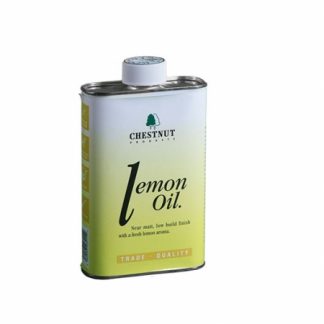 If you’re looking for a finish that won’t change the colour of your timber, won’t overpower the natural beauty of the wood with a high gloss but will still protect the timber and smell nice, well, you’re in the right place! Lemon Oil is a clear, low build finish. By that we mean that it’s a very thin liquid with a very low solids content, so no matter how much you apply it’s not going to build up to a discernible visible film on the surface. Instead it soaks in and seals the surface, offering a level of water resistance and protection against handling. Normally applied with a brush or a cloth it’s very easy to use and covers well and doesn’t usually show overlaps, so it’s ideal for large areas which often look better without a high gloss. And as you might expect, it has a pleasant lemon aroma too, although this does fade after a while.
If you’re looking for a finish that won’t change the colour of your timber, won’t overpower the natural beauty of the wood with a high gloss but will still protect the timber and smell nice, well, you’re in the right place! Lemon Oil is a clear, low build finish. By that we mean that it’s a very thin liquid with a very low solids content, so no matter how much you apply it’s not going to build up to a discernible visible film on the surface. Instead it soaks in and seals the surface, offering a level of water resistance and protection against handling. Normally applied with a brush or a cloth it’s very easy to use and covers well and doesn’t usually show overlaps, so it’s ideal for large areas which often look better without a high gloss. And as you might expect, it has a pleasant lemon aroma too, although this does fade after a while.
-
Out of stock
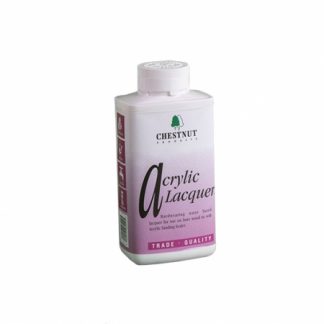
 If you need to get away from the smell and flammability of our cellulose based lacquers this is an ideal option.
This water based lacquer has virtually no smell and is totally non-flammable. Don’t be fooled though, this product is extremely hard wearing and gives a full gloss finish.
Being water based it is slightly slower drying, taking about twenty minutes to be touch dry. If you want to apply a second coat it should be left two hours before doing so, although a wax can be applied if required after about thirty minutes.
This product can be sprayed if suitable equipment is available, or can be applied by cloth or brush. We recommend foam brushes for application as this keeps the foaming action of acrylics to a minimum.
If you need to get away from the smell and flammability of our cellulose based lacquers this is an ideal option.
This water based lacquer has virtually no smell and is totally non-flammable. Don’t be fooled though, this product is extremely hard wearing and gives a full gloss finish.
Being water based it is slightly slower drying, taking about twenty minutes to be touch dry. If you want to apply a second coat it should be left two hours before doing so, although a wax can be applied if required after about thirty minutes.
This product can be sprayed if suitable equipment is available, or can be applied by cloth or brush. We recommend foam brushes for application as this keeps the foaming action of acrylics to a minimum.
-

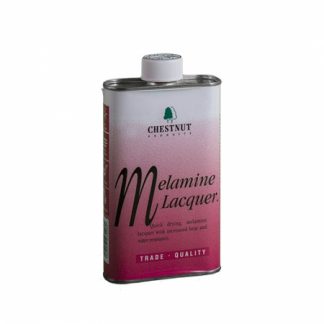
 When you’re looking for a hard-wearing, heat and water resistant, quick drying gloss lacquer you need look no further than Melamine Lacquer.
Based on cellulose technology, Melamine Lacquer has a catalyst suspended within it; when the lacquer is in the can it is inert but once applied and exposed to the air, the lacquer dries within five minutes like a cellulose and then the catalyst kicks in and the lacquer goes on to chemically cure to give a more durable coating. 90% of the curing process happens in the first seven days after application, making the lacquer very hard wearing, the remaining 10% of the process can take up to two weeks more to give maximum toughness, something you only need to consider if the lacquer is going to be subjected to extremely hard use.
Melamine Lacquer is designed to give a full gloss finish which will be achieved with a very careful application. It can be applied by brush (foam or bristle), cloth or by spraying. Where necessary, use cellulose thinners to dilute the product – especially helpful if working on a large area.
The gloss level of Melamine Lacquer can be increased by using burnishing cream once it has dried, and it can also be overcoated with friction polish (to increase the depth of the shine) or woodwax 22 or microcrystalline wax (for a more natural feel).
When you’re looking for a hard-wearing, heat and water resistant, quick drying gloss lacquer you need look no further than Melamine Lacquer.
Based on cellulose technology, Melamine Lacquer has a catalyst suspended within it; when the lacquer is in the can it is inert but once applied and exposed to the air, the lacquer dries within five minutes like a cellulose and then the catalyst kicks in and the lacquer goes on to chemically cure to give a more durable coating. 90% of the curing process happens in the first seven days after application, making the lacquer very hard wearing, the remaining 10% of the process can take up to two weeks more to give maximum toughness, something you only need to consider if the lacquer is going to be subjected to extremely hard use.
Melamine Lacquer is designed to give a full gloss finish which will be achieved with a very careful application. It can be applied by brush (foam or bristle), cloth or by spraying. Where necessary, use cellulose thinners to dilute the product – especially helpful if working on a large area.
The gloss level of Melamine Lacquer can be increased by using burnishing cream once it has dried, and it can also be overcoated with friction polish (to increase the depth of the shine) or woodwax 22 or microcrystalline wax (for a more natural feel).

-
Out of stock

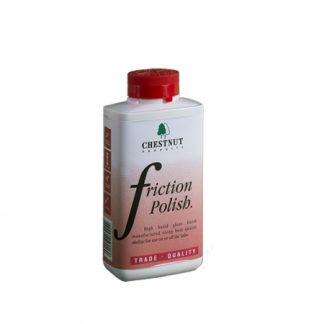 Friction Polish is a shellac based polish ideal for creating a high gloss finish on or off the lathe. It’s a great decorative finish and is ideal for small items but can be difficult to apply to larger items on the lathe (over about 8 inch diameter). The high amount of shellac in Friction Polish does two main things. Firstly it helps seal bare wood and give it a great shine, which is good. Sadly the price of this commodity shot up a few years ago when the shellac crop failed and it never went back down, meaning that the cost of the polish has also risen sharply. Nevertheless, Friction Polish remains one of the most popular finishes for turners. It can be applied to bare wood but is normally used over a sealer and any of the sealers in the Chestnut Products range are suitable for this. Applied with the lathe running it dries almost instantly and builds to a deep, rich shine very quickly. Avoid using too much as this can cause ‘rings’ to appear on the surface. Friction Polish can be applied off the lathe with great success, using it like a French Polish and rubbing it into the surface. This does require a large amount of elbow grease (sadly not something we supply) but the end result is well worth the effort!
Friction Polish is a shellac based polish ideal for creating a high gloss finish on or off the lathe. It’s a great decorative finish and is ideal for small items but can be difficult to apply to larger items on the lathe (over about 8 inch diameter). The high amount of shellac in Friction Polish does two main things. Firstly it helps seal bare wood and give it a great shine, which is good. Sadly the price of this commodity shot up a few years ago when the shellac crop failed and it never went back down, meaning that the cost of the polish has also risen sharply. Nevertheless, Friction Polish remains one of the most popular finishes for turners. It can be applied to bare wood but is normally used over a sealer and any of the sealers in the Chestnut Products range are suitable for this. Applied with the lathe running it dries almost instantly and builds to a deep, rich shine very quickly. Avoid using too much as this can cause ‘rings’ to appear on the surface. Friction Polish can be applied off the lathe with great success, using it like a French Polish and rubbing it into the surface. This does require a large amount of elbow grease (sadly not something we supply) but the end result is well worth the effort!
-

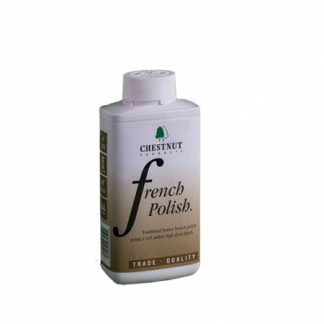 Confusingly, French Polish refers to a range of polishes (which would include Button Polish, White Polish, Garnet Polish etc) and also to a specific polish, French Polish. Chestnuts' French Polish is a traditional blend of solvent (methylated spirit) and a top quality unbleached shellac which is very similar to a Button Polish in colour. Applied either to bare timber or over a Shellac Sanding Sealer it is built up in many layers which have been described as being the thickness of a cigarette paper! French Polish gives the rich amber glow found on fine antique furniture and requires a very specific technique for application that is time consuming and laborious, but the final effect has to be seen to be believed and the satisfaction of achieving it is its own reward. A French Polish finish is not very hard wearing and is recommended for items that are going to be cared for.
Confusingly, French Polish refers to a range of polishes (which would include Button Polish, White Polish, Garnet Polish etc) and also to a specific polish, French Polish. Chestnuts' French Polish is a traditional blend of solvent (methylated spirit) and a top quality unbleached shellac which is very similar to a Button Polish in colour. Applied either to bare timber or over a Shellac Sanding Sealer it is built up in many layers which have been described as being the thickness of a cigarette paper! French Polish gives the rich amber glow found on fine antique furniture and requires a very specific technique for application that is time consuming and laborious, but the final effect has to be seen to be believed and the satisfaction of achieving it is its own reward. A French Polish finish is not very hard wearing and is recommended for items that are going to be cared for.
-

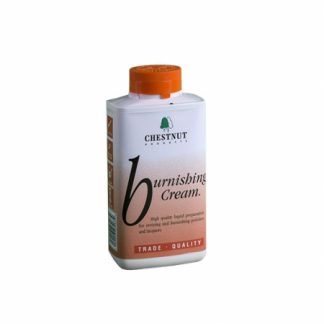 This creamy liquid has a very mild abrasive within it which acts like ‘liquid sandpaper’ on finished surfaces, cutting back and cleaning the finish and elevating it to a glossier, brighter finish. It can be used to smooth Cellulose Sanding Sealer prior to applying wax or Friction Polish, or, after allowing a suitable time to dry, on any of the lacquers, Friction Polish, Finishing Oil or Hard Wax Oil. A deep finish can be achieved using Burnishing Cream on a coat of Melamine Lacquer, then a coat of Friction Polish and finally the Burnishing Cream again. Use it sparingly so as not to over lubricate the surface and be sure to shake the bottle before use. It is not advisable to use a lacquer on top of a surface that has had Burnishing Cream used on it.
This creamy liquid has a very mild abrasive within it which acts like ‘liquid sandpaper’ on finished surfaces, cutting back and cleaning the finish and elevating it to a glossier, brighter finish. It can be used to smooth Cellulose Sanding Sealer prior to applying wax or Friction Polish, or, after allowing a suitable time to dry, on any of the lacquers, Friction Polish, Finishing Oil or Hard Wax Oil. A deep finish can be achieved using Burnishing Cream on a coat of Melamine Lacquer, then a coat of Friction Polish and finally the Burnishing Cream again. Use it sparingly so as not to over lubricate the surface and be sure to shake the bottle before use. It is not advisable to use a lacquer on top of a surface that has had Burnishing Cream used on it.
-

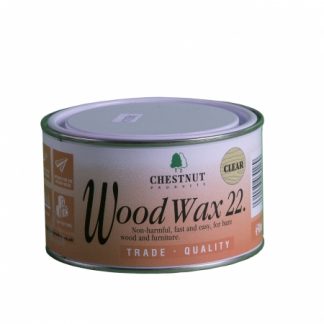
 WoodWax 22 contains beeswax (for shine) and carnauba wax (for hardness). Blended together in a solvent to produce a soft creamy paste. This makes it very easy to apply over any surface.
WoodWax 22 is quick drying enough to be applied onto unsealed wood but works best on one of Chestnuts sanding sealers.
If working on the lathe the wax should be applied with the lathe stopped.
Apply using a cloth (Safety Cloth or Stockinette works well with this); the wax spreads easily over the surface, after about 20 seconds it starts to drag slightly. This means it is ready to buff up; if you haven’t covered the whole piece by then don’t worry, just take a little more wax from the tin and carry on applying, the wax won’t mind waiting!
It’s best to buff WoodWax 22 as soon as you can; that way any surplus wax that might have been applied will be removed, allowing the shine to really show through.
If working on the lathe Safety Cloth should be used for the buffing process and let the lathe do the work for you. Off the lathe Safety Cloth or Stockinette can be used.
A second or even third coat of wax can be applied if required, leaving about twenty minutes between coats. After three coats the finish can become softer and will mark very easily.
WoodWax 22 contains beeswax (for shine) and carnauba wax (for hardness). Blended together in a solvent to produce a soft creamy paste. This makes it very easy to apply over any surface.
WoodWax 22 is quick drying enough to be applied onto unsealed wood but works best on one of Chestnuts sanding sealers.
If working on the lathe the wax should be applied with the lathe stopped.
Apply using a cloth (Safety Cloth or Stockinette works well with this); the wax spreads easily over the surface, after about 20 seconds it starts to drag slightly. This means it is ready to buff up; if you haven’t covered the whole piece by then don’t worry, just take a little more wax from the tin and carry on applying, the wax won’t mind waiting!
It’s best to buff WoodWax 22 as soon as you can; that way any surplus wax that might have been applied will be removed, allowing the shine to really show through.
If working on the lathe Safety Cloth should be used for the buffing process and let the lathe do the work for you. Off the lathe Safety Cloth or Stockinette can be used.
A second or even third coat of wax can be applied if required, leaving about twenty minutes between coats. After three coats the finish can become softer and will mark very easily.

-

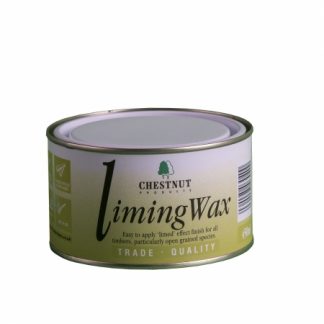 The white pigment in Liming Wax is Titanium Dioxide (TiO2) which gives it a brilliant white finish which will perfectly highlight open grain. Use Liming Wax on any open grained timber for a dramatic and striking effect which can be emphasised by using a stain or Ebonising Lacquer first. For an even better result use the Liming Brush first to open up the grain, allowing more Liming Wax to enter; spread the Liming Wax over the whole surface and then wipe off after a few minutes. The Liming Wax will stay in the open grain and the effect will be instantly visible. Whilst Liming Wax is a wax (obviously!), the wax is mainly a carrier for the white pigment. Therefore an overcoat of some kind is needed. WoodWax 22, Microcrystalline Wax, Finishing Oil or Hard Wax Oil are ideal for this and will lock the wax in place whilst keeping it clean and bright.
The white pigment in Liming Wax is Titanium Dioxide (TiO2) which gives it a brilliant white finish which will perfectly highlight open grain. Use Liming Wax on any open grained timber for a dramatic and striking effect which can be emphasised by using a stain or Ebonising Lacquer first. For an even better result use the Liming Brush first to open up the grain, allowing more Liming Wax to enter; spread the Liming Wax over the whole surface and then wipe off after a few minutes. The Liming Wax will stay in the open grain and the effect will be instantly visible. Whilst Liming Wax is a wax (obviously!), the wax is mainly a carrier for the white pigment. Therefore an overcoat of some kind is needed. WoodWax 22, Microcrystalline Wax, Finishing Oil or Hard Wax Oil are ideal for this and will lock the wax in place whilst keeping it clean and bright.
-

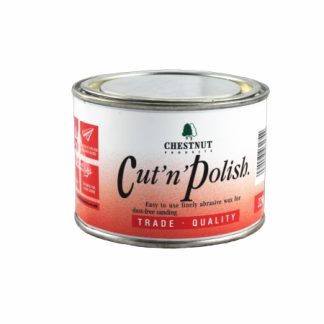 Cut’n’Polish is a blend of two waxes with a fine abrasive held in suspension within them. This is a soft wax designed to stay ‘wet’ slightly longer during application, allowing it to lubricate the abrasive to give a very fine cut to the timber and also to collect any dust generated during use and some subsequent sanding, preventing it from entering the workshop atmosphere. On bare wood; sand to 240 grit as normal, apply a coat of Cut’n’Polish with the lathe stopped, then switch on the lathe and buff to a soft sheen whilst smoothing the timber at the same time. On sealed wood apply after the sealer in the same way, polishing to a slightly higher shine. Cut’n’Polish dries almost immediately and can be overcoated with Friction Polish or any Chestnut waxes for a higher shine.
Cut’n’Polish is a blend of two waxes with a fine abrasive held in suspension within them. This is a soft wax designed to stay ‘wet’ slightly longer during application, allowing it to lubricate the abrasive to give a very fine cut to the timber and also to collect any dust generated during use and some subsequent sanding, preventing it from entering the workshop atmosphere. On bare wood; sand to 240 grit as normal, apply a coat of Cut’n’Polish with the lathe stopped, then switch on the lathe and buff to a soft sheen whilst smoothing the timber at the same time. On sealed wood apply after the sealer in the same way, polishing to a slightly higher shine. Cut’n’Polish dries almost immediately and can be overcoated with Friction Polish or any Chestnut waxes for a higher shine.
-

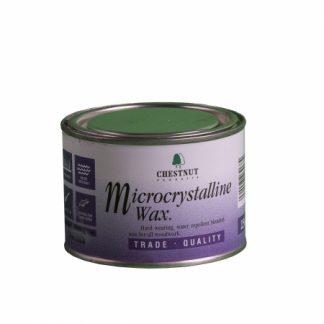
 Chestnut Products’ Microcrystalline Wax is a blend of high quality waxes rich in microcrystalline wax – a wax derived from the petroleum refining process and known for the fineness of its crystals.
This is mixed with a special solvent to create a firm wax which, when dry, knits down to form a very dense coating making it very water resistant, meaning that it is ideal for any items that are likely to come into contact with water for short periods of time.
Microcrystalline waxes also have a higher melting point than other waxes traditionally used to make polishing waxes, the benefit of which is that repeated handling of items finished in Microcrystalline Wax won’t finger mark in the same way, as the melting point is higher than normal body temperature.
Microcrystalline Wax should be used over one of the Chestnut Products’ sanding sealers and allowed to dry (about 20 minutes) before buffing to a shine.
For best results apply a very thin coat, spreading the wax evenly over the entire surface.
Microcrystalline Wax can also be used on the buffing wheel system. In this situation use the A and B Wheel as normal, then apply the Microcrystalline Wax to the item you are polishing. Allow 20 minutes for the wax to dry then buff and normal using the C Wheel. You can use the same C Wheel for both Microcrystalline Wax and the Carnuaba Wax Stick.
Microcrystalline Wax has been tested to the EN71 Part 3 regulations regarding coatings used on toys.
Chestnut Products’ Microcrystalline Wax is a blend of high quality waxes rich in microcrystalline wax – a wax derived from the petroleum refining process and known for the fineness of its crystals.
This is mixed with a special solvent to create a firm wax which, when dry, knits down to form a very dense coating making it very water resistant, meaning that it is ideal for any items that are likely to come into contact with water for short periods of time.
Microcrystalline waxes also have a higher melting point than other waxes traditionally used to make polishing waxes, the benefit of which is that repeated handling of items finished in Microcrystalline Wax won’t finger mark in the same way, as the melting point is higher than normal body temperature.
Microcrystalline Wax should be used over one of the Chestnut Products’ sanding sealers and allowed to dry (about 20 minutes) before buffing to a shine.
For best results apply a very thin coat, spreading the wax evenly over the entire surface.
Microcrystalline Wax can also be used on the buffing wheel system. In this situation use the A and B Wheel as normal, then apply the Microcrystalline Wax to the item you are polishing. Allow 20 minutes for the wax to dry then buff and normal using the C Wheel. You can use the same C Wheel for both Microcrystalline Wax and the Carnuaba Wax Stick.
Microcrystalline Wax has been tested to the EN71 Part 3 regulations regarding coatings used on toys.

-

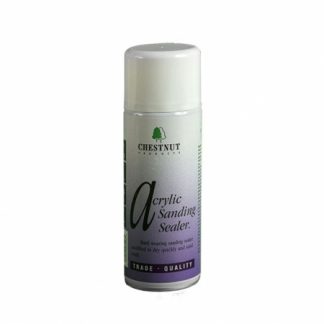
 It’s important to use a sanding sealer on most items; it gives a good foundation to your piece and can help the next coat to adhere properly to the timber.
Chestnut Acrylic Sanding Sealer does this perfectly and is designed to be used with Acrylic Gloss Lacquer, Acrylic Satin Lacquer, Ebonising Lacquer, any of their polishes and any of their waxes.
Supplied in an easy to use aerosol the dried coating complies with the EN71 Part 3 regulations governing toys and nursery furniture.
Once dried lightly sand back prior to applying your top coat.
It’s important to use a sanding sealer on most items; it gives a good foundation to your piece and can help the next coat to adhere properly to the timber.
Chestnut Acrylic Sanding Sealer does this perfectly and is designed to be used with Acrylic Gloss Lacquer, Acrylic Satin Lacquer, Ebonising Lacquer, any of their polishes and any of their waxes.
Supplied in an easy to use aerosol the dried coating complies with the EN71 Part 3 regulations governing toys and nursery furniture.
Once dried lightly sand back prior to applying your top coat.

-

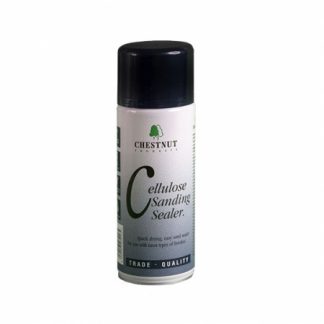
 Getting a good base for your finishing is essential when you want to get a great finish. Sometimes the piece you’re working on makes that more difficult due to its shape or size or for many other reasons.
Or sometimes you just want a quicker, cleaner method of applying a sealer.
That’s where Cellulose Sanding Sealer in an aerosol comes into its own. Basically the same product as in the tin, it has all the same benefits of quick drying and universal compatibility, it also has the added advantage of being easier both to apply and to get an even coating.
Use it before applying waxes, lacquers and polishes for a more durable final finish.
Getting a good base for your finishing is essential when you want to get a great finish. Sometimes the piece you’re working on makes that more difficult due to its shape or size or for many other reasons.
Or sometimes you just want a quicker, cleaner method of applying a sealer.
That’s where Cellulose Sanding Sealer in an aerosol comes into its own. Basically the same product as in the tin, it has all the same benefits of quick drying and universal compatibility, it also has the added advantage of being easier both to apply and to get an even coating.
Use it before applying waxes, lacquers and polishes for a more durable final finish.

-

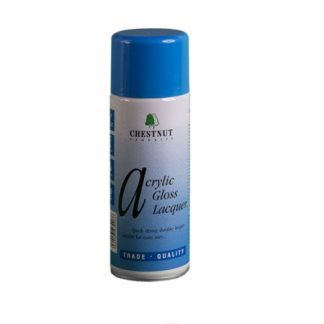
 If you don’t have access to spraying equipment, this aerosol lacquer will give you a great finish quickly and easily. A spray application is particularly relevant when trying to achieve the best gloss finish possible. Acrylic Gloss Lacquer is a high build water based lacquer specially adapted to give the best delivery through the nozzle (chosen to give excellent results without spitting, spotting or clogging in normal use) without, of course, the use of CFCs.
The lacquer itself dries quickly to give a high gloss finish straight from the can which has the benefit of being extremely hard wearing and durable – so much so that it can be used on items that will be kept outdoors or used in areas where moisture could damage other finishes.
Acrylic Gloss Lacquer is touch dry and tack free in around five minutes and hard dry in twenty minutes, ready for a second coat if needed after a light rubdown with a fine abrasive.
The sheen level can be increased if required by using Burnishing Cream (which will not affect the durability) or, after allowing 24 hours to ensure it is completely hard dry, by using it in conjunction with the Buffing Wheel Kit.
If you don’t have access to spraying equipment, this aerosol lacquer will give you a great finish quickly and easily. A spray application is particularly relevant when trying to achieve the best gloss finish possible. Acrylic Gloss Lacquer is a high build water based lacquer specially adapted to give the best delivery through the nozzle (chosen to give excellent results without spitting, spotting or clogging in normal use) without, of course, the use of CFCs.
The lacquer itself dries quickly to give a high gloss finish straight from the can which has the benefit of being extremely hard wearing and durable – so much so that it can be used on items that will be kept outdoors or used in areas where moisture could damage other finishes.
Acrylic Gloss Lacquer is touch dry and tack free in around five minutes and hard dry in twenty minutes, ready for a second coat if needed after a light rubdown with a fine abrasive.
The sheen level can be increased if required by using Burnishing Cream (which will not affect the durability) or, after allowing 24 hours to ensure it is completely hard dry, by using it in conjunction with the Buffing Wheel Kit.

-

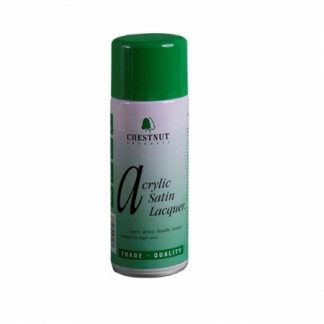
 When you need to protect your work but don’t want an overpowering shine on it, Acrylic Satin Lacquer is an ideal choice. With the benefit of an easy aerosol application, especially useful on awkward shapes, this is a hard wearing water based lacquer that will protect whatever it’s put onto, leaving an attractive satin sheen.
Acrylic Satin Lacquer is touch dry and dust free in about five minutes and hard dry about 20 minutes, ready for a second coat if needed after a light cut back with a fine abrasive.
For best results it should be used over either Cellulose Sanding Sealer or the Acrylic Sanding Sealer aerosol.
If you have a change of heart on the finish the lacquer can be brought to a gloss by using either Burnishing Cream or the Buffing Wheel Kit. Or you can simply apply a coat of Acrylic Gloss Lacquer!
When you need to protect your work but don’t want an overpowering shine on it, Acrylic Satin Lacquer is an ideal choice. With the benefit of an easy aerosol application, especially useful on awkward shapes, this is a hard wearing water based lacquer that will protect whatever it’s put onto, leaving an attractive satin sheen.
Acrylic Satin Lacquer is touch dry and dust free in about five minutes and hard dry about 20 minutes, ready for a second coat if needed after a light cut back with a fine abrasive.
For best results it should be used over either Cellulose Sanding Sealer or the Acrylic Sanding Sealer aerosol.
If you have a change of heart on the finish the lacquer can be brought to a gloss by using either Burnishing Cream or the Buffing Wheel Kit. Or you can simply apply a coat of Acrylic Gloss Lacquer!

-

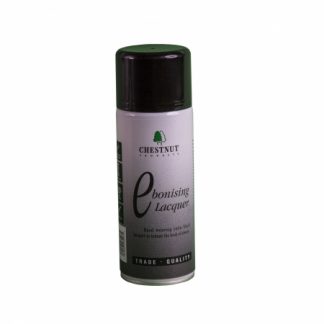
 Ebonising Lacquer is a tough, hard-wearing water-based lacquer. It is heavily pigmented so that when it is dry it emulates the classic satin look of ebony.
Usually applied over a sanding sealer (either Cellulose Sanding Sealer or Acrylic Sanding Sealer aerosol) it is touch dry in about five minutes and hard dry after twenty minutes.
Although heavily pigmented it is not paint and will still allow the grain of the timber to show through, rather than obliterating it completely.
Liming Wax and Gilt Cream can be applied over Ebonising Lacquer to give a pleasing, eye-catching yet very simple artistic effect.
If a bright gloss finish is required from Ebonising Lacquer this is best achieved by using Burnishing Cream on the lacquer with will polish it up to a high gloss.
Acrylic Gloss Lacquer can also be applied on top of Ebonising Lacquer, as can WoodWax 22 and Microcrystalline Wax.
Ebonising Lacquer is a tough, hard-wearing water-based lacquer. It is heavily pigmented so that when it is dry it emulates the classic satin look of ebony.
Usually applied over a sanding sealer (either Cellulose Sanding Sealer or Acrylic Sanding Sealer aerosol) it is touch dry in about five minutes and hard dry after twenty minutes.
Although heavily pigmented it is not paint and will still allow the grain of the timber to show through, rather than obliterating it completely.
Liming Wax and Gilt Cream can be applied over Ebonising Lacquer to give a pleasing, eye-catching yet very simple artistic effect.
If a bright gloss finish is required from Ebonising Lacquer this is best achieved by using Burnishing Cream on the lacquer with will polish it up to a high gloss.
Acrylic Gloss Lacquer can also be applied on top of Ebonising Lacquer, as can WoodWax 22 and Microcrystalline Wax.

-

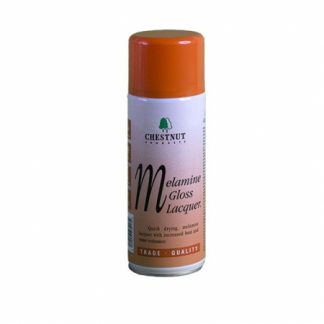
 Melamine Lacquer can be a bit fiddly to apply and there’s no better way than spraying it. If you don’t have access to spray equipment then this aerosol version is the ideal way.
Melamine Gloss Lacquer will quickly build to a bright gloss finish and dries in a matter of minutes.
Touch dry and safe to handle within five minutes the lacquer chemically cures to give a tougher finish. The lacquer achieves practically all of this (about 90%) within seven days, after which the process slows and can take up to another two weeks to fully complete.
Best used over a Cellulose Sanding Sealer (brushing or aerosol) and can be overcoated with a wax for a softer tactile feel.
Melamine Lacquer can be a bit fiddly to apply and there’s no better way than spraying it. If you don’t have access to spray equipment then this aerosol version is the ideal way.
Melamine Gloss Lacquer will quickly build to a bright gloss finish and dries in a matter of minutes.
Touch dry and safe to handle within five minutes the lacquer chemically cures to give a tougher finish. The lacquer achieves practically all of this (about 90%) within seven days, after which the process slows and can take up to another two weeks to fully complete.
Best used over a Cellulose Sanding Sealer (brushing or aerosol) and can be overcoated with a wax for a softer tactile feel.

-
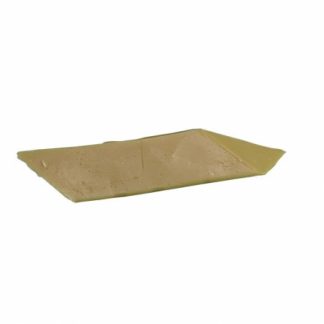 Woodturners stick wax is a mixture of beeswax and carnauba wax it is slightly softer than the Carnauba Wax Stick and therefore slightly easier to apply and there are no concerns about it marking softer woods. Applied over a sanding sealer, simply hold the stick against the revolving work and allow the heat generated to melt the wax onto the wood. Buff up straight away using Safety Cloth, using the cloth to ensure an even coating.
Woodturners stick wax is a mixture of beeswax and carnauba wax it is slightly softer than the Carnauba Wax Stick and therefore slightly easier to apply and there are no concerns about it marking softer woods. Applied over a sanding sealer, simply hold the stick against the revolving work and allow the heat generated to melt the wax onto the wood. Buff up straight away using Safety Cloth, using the cloth to ensure an even coating. -
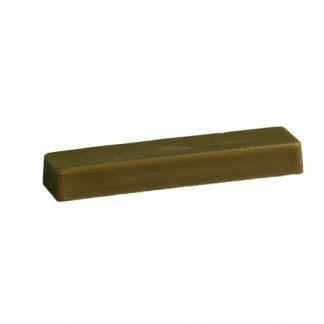 This is a solid block of carnauba wax, popular with woodturners. It gives a bright gloss finish and is also very hard wearing, able to withstand a medium amount of handling without showing finger marks. Apply over a sanding sealer by holding it against your work at it revolves on the lathe. Do not press too much – the wax is very hard and can scratch softer woods – the idea is to generate enough heat for the wax to melt slightly and transfer onto the wood. (This is easier than it sounds!). Use sparingly, and use the polishing process (using safety cloth) to ensure the wax is spread evenly. Buffing will produce a high gloss finish.
This is a solid block of carnauba wax, popular with woodturners. It gives a bright gloss finish and is also very hard wearing, able to withstand a medium amount of handling without showing finger marks. Apply over a sanding sealer by holding it against your work at it revolves on the lathe. Do not press too much – the wax is very hard and can scratch softer woods – the idea is to generate enough heat for the wax to melt slightly and transfer onto the wood. (This is easier than it sounds!). Use sparingly, and use the polishing process (using safety cloth) to ensure the wax is spread evenly. Buffing will produce a high gloss finish. -
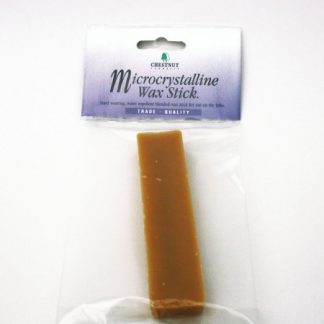
 This is the same wax Chestnut use in the tinned version of Microcrystalline Wax but in a solid block form with no solvent. This means there’s no waiting around for it to dry before buffing it.
Like the original version, this wax should be used very sparingly, a little goes a very long way and once applied it might even be necessary to spread it thinner using Safety Cloth (the texture of this makes it ideal for this purpose).
The Microcrystalline Wax Stick is also perfect for use on the Buffing Wheel System, use it on Wheel C to buff up to a brilliant, hard wearing finish.
This is the same wax Chestnut use in the tinned version of Microcrystalline Wax but in a solid block form with no solvent. This means there’s no waiting around for it to dry before buffing it.
Like the original version, this wax should be used very sparingly, a little goes a very long way and once applied it might even be necessary to spread it thinner using Safety Cloth (the texture of this makes it ideal for this purpose).
The Microcrystalline Wax Stick is also perfect for use on the Buffing Wheel System, use it on Wheel C to buff up to a brilliant, hard wearing finish. -

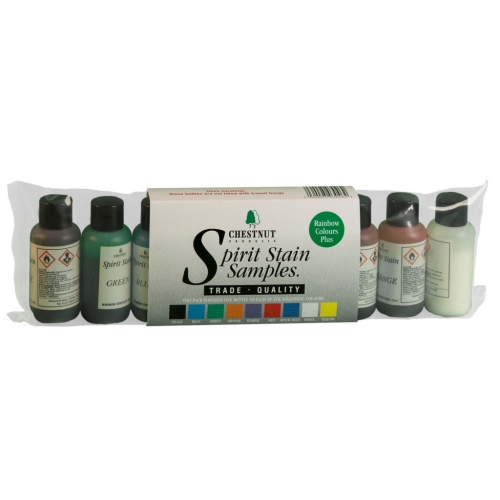
The ideal way to experiment with the different colours available to decide which ones you prefer, the Spirit Stain Kit contains one bottle (min. contents 25ml) of each of the nine colours. These are exactly the same stain as in the bigger bottles and will intermix if you want to vary the shades available.
The stains are very fade resistant, quick drying and non-grain raising.
-
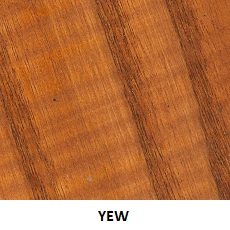
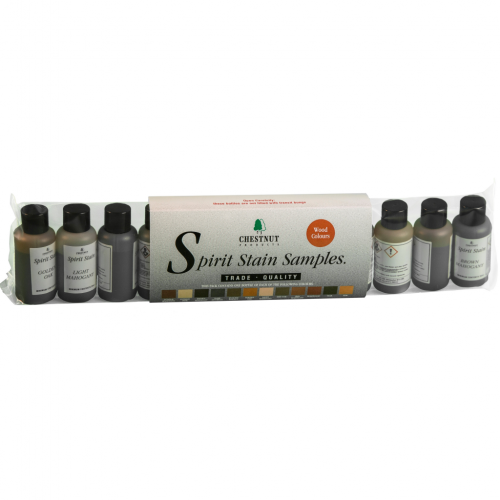 The ideal way to experiment with the different colours available to decide which ones you prefer, the Spirit Stain Kit contains one bottle (min. contents 25ml) of each of the twelve wood colours. These are exactly the same stain as in the bigger bottles and will intermix if you want to vary the shades available. The stains are very fade resistant, quick drying and non-grain raising.
The ideal way to experiment with the different colours available to decide which ones you prefer, the Spirit Stain Kit contains one bottle (min. contents 25ml) of each of the twelve wood colours. These are exactly the same stain as in the bigger bottles and will intermix if you want to vary the shades available. The stains are very fade resistant, quick drying and non-grain raising.
-

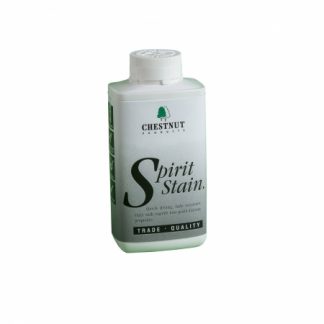 An exciting and vibrant set of colours for staining wood, Spirit Stains are methanol based to make them quick drying and because of this they also will not raise the grain of the timber they are applied to. The pigments used to make this stains are of the highest quality and all score the top ratings of 7s and 8s in the Blue Wool Scale, the measuring system used to rate fade resistance. This means you can use them with confidence knowing that the colour you apply will still be the same many years later. Spirit Stains are fully inter-mixable so you can produce virtually any colour you can think of, giving you full opportunity to be as creative as you wish. The colours will also mix after application so you can blend from one colour to another for fantastic ‘flare’ effects. Spirit Stain White is designed primarily as a mixer to create pastel shades when mixed with other Spirit Stain colours. It can be used to stain timber but as it is a translucent stain this can have a limited effect depending on the base colour of the timber used. Should you want a more subtle colour you can dilute the stains with Spirit Thinners for a delicate wash effect.
An exciting and vibrant set of colours for staining wood, Spirit Stains are methanol based to make them quick drying and because of this they also will not raise the grain of the timber they are applied to. The pigments used to make this stains are of the highest quality and all score the top ratings of 7s and 8s in the Blue Wool Scale, the measuring system used to rate fade resistance. This means you can use them with confidence knowing that the colour you apply will still be the same many years later. Spirit Stains are fully inter-mixable so you can produce virtually any colour you can think of, giving you full opportunity to be as creative as you wish. The colours will also mix after application so you can blend from one colour to another for fantastic ‘flare’ effects. Spirit Stain White is designed primarily as a mixer to create pastel shades when mixed with other Spirit Stain colours. It can be used to stain timber but as it is a translucent stain this can have a limited effect depending on the base colour of the timber used. Should you want a more subtle colour you can dilute the stains with Spirit Thinners for a delicate wash effect.
-
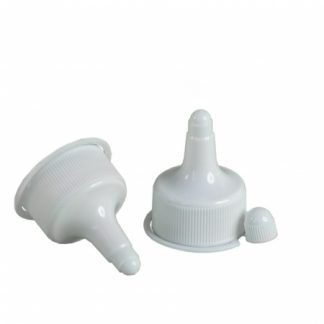 These Dispensing Nozzles are, in fact, almost indispensable! They fit onto any of Chestnuts' plastic bottles in the 250ml, 500ml and 1 ltr sizes, simply replacing the existing cap. Cut the tip off to the size you want and use the handy cover to reseal them when not in use. A useful by product of using these is that if you knock a bottle over the amount you lose through the small nozzle will be much less than without it. Just don’t forget to take the nozzle off the bottle before you throw it away so that you can re-use it! These nozzles are not child resistant, the correct closure should be replaced when the product is not in use.
These Dispensing Nozzles are, in fact, almost indispensable! They fit onto any of Chestnuts' plastic bottles in the 250ml, 500ml and 1 ltr sizes, simply replacing the existing cap. Cut the tip off to the size you want and use the handy cover to reseal them when not in use. A useful by product of using these is that if you knock a bottle over the amount you lose through the small nozzle will be much less than without it. Just don’t forget to take the nozzle off the bottle before you throw it away so that you can re-use it! These nozzles are not child resistant, the correct closure should be replaced when the product is not in use. -
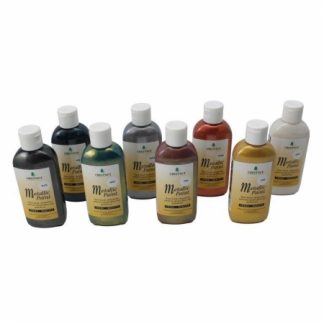 This exciting range of water-based acrylic paints comes in 8 metallic colours. Designed to add an even shimmer to your work they will really make it glow. Mix and match them, use them to highlight certain areas or cover everything in them, the choice is yours. Best used over sanding sealers, apply a spray lacquer over them once dry to seal them in. Can be applied by cloth, brush, spray gun, air brush or any suitable medium you choose!
This exciting range of water-based acrylic paints comes in 8 metallic colours. Designed to add an even shimmer to your work they will really make it glow. Mix and match them, use them to highlight certain areas or cover everything in them, the choice is yours. Best used over sanding sealers, apply a spray lacquer over them once dry to seal them in. Can be applied by cloth, brush, spray gun, air brush or any suitable medium you choose! -
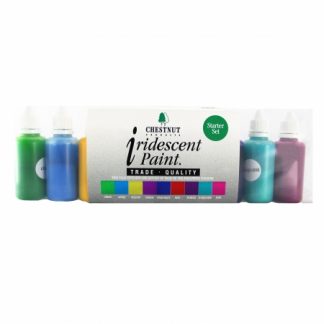 Iridescent Paints give a change in hue, a slight colour shift when viewed from different angles and are especially effective on irregularly shaped items.Available in nine different amazingly bright and vibrant colours –
Iridescent Paints give a change in hue, a slight colour shift when viewed from different angles and are especially effective on irregularly shaped items.Available in nine different amazingly bright and vibrant colours –- Green
- Azure
- Purple
- Red
- Turquoise
- Cerise
- Pink
- Yellow
- Vivid Blue
The paints are water based acrylics and can be applied by brush, cloth, spray gun/airbrush or any manner of ways to give interesting decorative effects. -
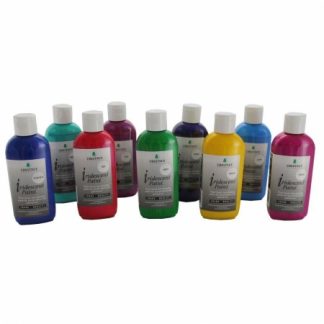 Iridescent Paints give a change in hue, a slight colour shift when viewed from different angles and are especially effective on irregularly shaped items.Available in nine different amazingly bright and vibrant colours –
Iridescent Paints give a change in hue, a slight colour shift when viewed from different angles and are especially effective on irregularly shaped items.Available in nine different amazingly bright and vibrant colours –- Green
- Azure
- Purple
- Red
- Turquoise
- Cerise
- Pink
- Yellow
- Vivid Blue
The paints are water based acrylics and can be applied by brush, cloth, spray gun/airbrush or any manner of ways to give interesting decorative effects. -
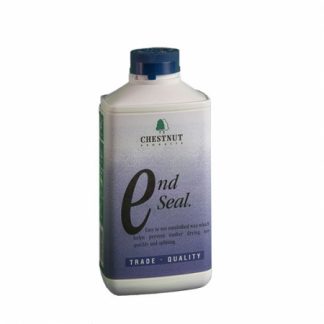 End Seal is an emulsified paraffin wax used the seal the ends of freshly cut timber to slow down the drying process and reduce the risk of the timber splitting. It can also be used on work-in-progress that is being left unfinished where there is a risk of the timber splitting. Apply it liberally, normally by brush but it can be sprayed if needed, usually to the smallest surface of the timber which will normally be the end grain where moisture is most likely to escape from. Sealing the surface will encourage the moisture to escape via the larger areas which will result in a slower exit.
End Seal is an emulsified paraffin wax used the seal the ends of freshly cut timber to slow down the drying process and reduce the risk of the timber splitting. It can also be used on work-in-progress that is being left unfinished where there is a risk of the timber splitting. Apply it liberally, normally by brush but it can be sprayed if needed, usually to the smallest surface of the timber which will normally be the end grain where moisture is most likely to escape from. Sealing the surface will encourage the moisture to escape via the larger areas which will result in a slower exit. -

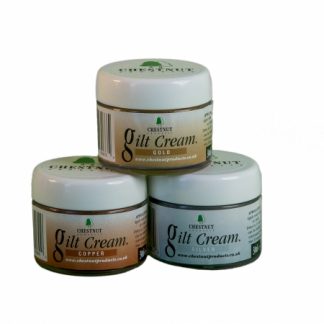 Gilt Creams are a creamy, waxy paste with metallic flakes and pigments in them, giving a rich, lustrous finish to whatever they are applied to. The can be used for a ‘limed’ effect over a lacquer to give a high contrast effect, or uniformly over a piece and polished to a bright shine once dried. Available in
Gilt Creams are a creamy, waxy paste with metallic flakes and pigments in them, giving a rich, lustrous finish to whatever they are applied to. The can be used for a ‘limed’ effect over a lacquer to give a high contrast effect, or uniformly over a piece and polished to a bright shine once dried. Available in- Gold
- Silver
- Copper

-
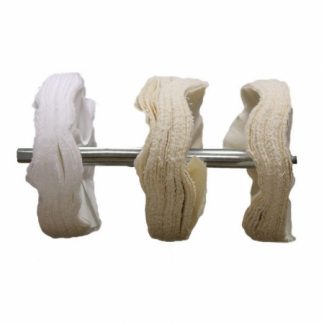 The Buffing Tree comprises of three 6 inch wheels, in the A, B and C cloth grades, firmly held on a central spindle. It’s ideal for buffing small items and, after loading the wheels with the compounds and wax, allows you to move from one wheel to the next in quick succession, dramatically reducing the time otherwise taken up by changing wheels. Ideal for polishing small items such as fruit, pens, boxes etc in batches. Requires one of our mandrels to fix to the chuck and a live centre for support at the tailstock. PLEASE NOTE: The Buffing Tree does not come as kit containing the mandrels and compounds etc; this is deliberate as if you already use the Buffing System you will have these and won’t want to buy them again. If you do not have these items they are available to purchase separately or as a pack in the Buffing Accessory Pack.
The Buffing Tree comprises of three 6 inch wheels, in the A, B and C cloth grades, firmly held on a central spindle. It’s ideal for buffing small items and, after loading the wheels with the compounds and wax, allows you to move from one wheel to the next in quick succession, dramatically reducing the time otherwise taken up by changing wheels. Ideal for polishing small items such as fruit, pens, boxes etc in batches. Requires one of our mandrels to fix to the chuck and a live centre for support at the tailstock. PLEASE NOTE: The Buffing Tree does not come as kit containing the mandrels and compounds etc; this is deliberate as if you already use the Buffing System you will have these and won’t want to buy them again. If you do not have these items they are available to purchase separately or as a pack in the Buffing Accessory Pack. -
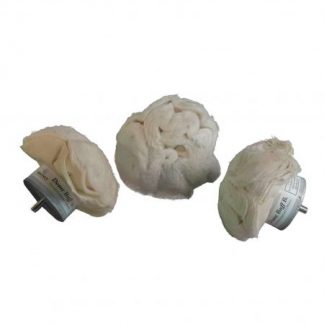 These unstitched, cotton mops are ideal for polishing the insides of bowls and boxes etc to achieve the same great finish on the inside as on the outside when using the Buffing Wheel kit, without the fear of the item being snatched from your hands by the larger Buffing Wheels. All of the domes share the same thread as in the large mandrel and the small mandrel so all parts are completely interchangeable. Due to the smaller size of these dome buffs they will require more time and sometimes more speed on the lathe to be able to match the finish given by the larger wheels. Dome Buff A is used with compound 1 to cut back the applied finish and remove any minor blemishes left behind by sanding. Dome Buff B is used with Compound 2 to cleanse the piece and also to prepare for the final polish coat by giving an exceptionally smooth surface. Dome Buff C is used with either the Carnauba wax stick, microcrystalline wax or Microcrystalline Wax Stick to give a wonderful, long lasting shine.
These unstitched, cotton mops are ideal for polishing the insides of bowls and boxes etc to achieve the same great finish on the inside as on the outside when using the Buffing Wheel kit, without the fear of the item being snatched from your hands by the larger Buffing Wheels. All of the domes share the same thread as in the large mandrel and the small mandrel so all parts are completely interchangeable. Due to the smaller size of these dome buffs they will require more time and sometimes more speed on the lathe to be able to match the finish given by the larger wheels. Dome Buff A is used with compound 1 to cut back the applied finish and remove any minor blemishes left behind by sanding. Dome Buff B is used with Compound 2 to cleanse the piece and also to prepare for the final polish coat by giving an exceptionally smooth surface. Dome Buff C is used with either the Carnauba wax stick, microcrystalline wax or Microcrystalline Wax Stick to give a wonderful, long lasting shine.


